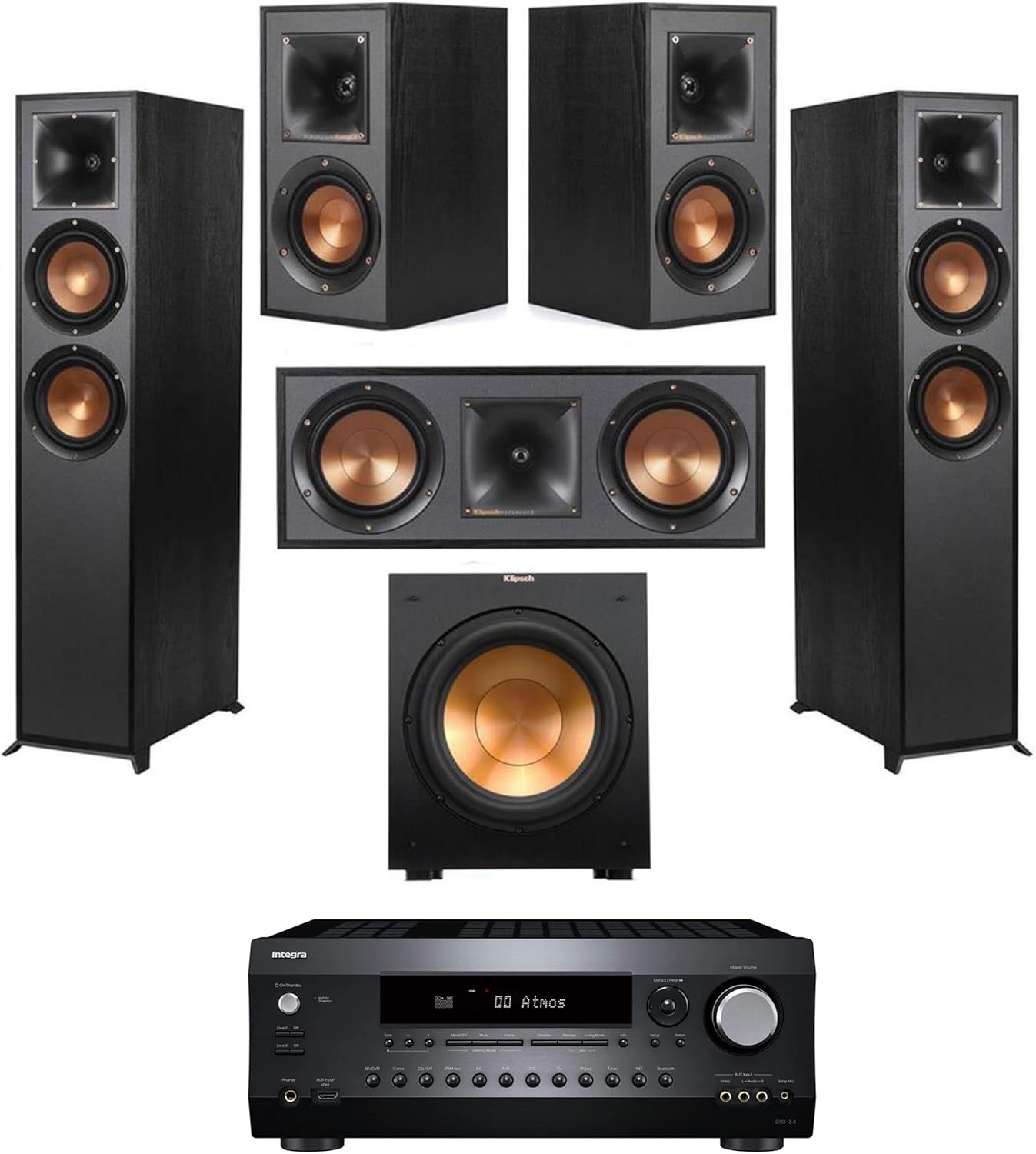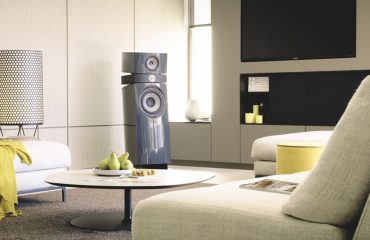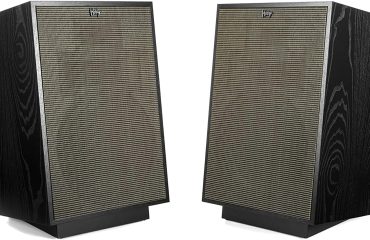Placing Home Theater Speakers
How do you get five elephants into your car? Two in the front, three in the back. With video speakers it’s the opposite–three in the front and two in the back. But is that all you need to know?
Yes, yes, we know…just placing two speakers for stereo is tough enough. But five? A quarter century ago, quadraphonic sound was killed off by the difficulties of placing four loudspeakers in a multipurpose living room. Is there a message here?
The tough ones to place, you’d think, would be the rear speakers. And we’ll get to the special difficulties of rear speakers in a moment, but first let’s have a look at the left and right front speakers, sometimes called the main speakers.
In a Dolby Pro Logic system, there is good reason to call them “main” speakers. The Dolby Surround model has only two rear channels, and “decoding” extra channels from them requires a kind of math not taught in any schools we know of. The extra speakers (sometimes inaccurately called “channels”) simply present the same information as the main speakers, but in a different configuration (for the details, see Inside Surround Sound in UHF No. 37). Of course, discrete surround (AC-3 or DTS) is another matter.
The main speakers
Start with just those speakers, and nothing else. It’s obvious that they will need to be placed on either side of the video screen, but that still leaves room for variations, and those variations can make the difference between an exciting system and one that is merely loud.
A moment’s thought confirms that there are essentially two possibilities. The speakers can be placed close to the monitor or far apart. And they can be placed well forward or further back. There is no “right” way to do it, and you’ll need to experiment.
First, consider how far out into the room the speakers should be. It’s not a terrific idea to place something large, such as a TV set, right between the speakers, because the set will cause a phenomenon known as diffraction: sound waves passing by the set’s edges will bend, so that the edges become in effect new sound sources. So you’ll want to pull the speakers forward, right?
But in fact not necessarily. Forget the TV for a moment, and try different distances from the rear wall. Does the sound change? Of course it does. Some loudspeakers — such as Totem, Quad, or Martin-Logan — actually must be placed well out from the rear wall. Others, such as those from Linn, are designed to work best right against the wall. Check out different positions using music, not movie sound, and judge the results by the criteria you would use in judging a music system. Listen particularly to the bottom end, which may be tubby, or too thin, or just weird. Or just right, which is what you’re trying for.
Now…far apart or close together?
Once again you’ll need to experiment, just as you would if the TV set weren’t there and this were just a stereo music system. Add extra cable, if necessary, so that you can move the speakers around, and set aside a few hours for experimentation. Tests are best done with a monophonic source, which can be an old pre-stereo recording (but one without “stereo” reverberation added to “improve” it), or even an FM tuner set to mono. When you have the right placement, the sound will seem to come from an invisible speaker right between the actual speakers. Once you’ve found that spot, try some recordings that are done in true stereo, such as those from Opus 3, Proprius, Audioquest, etc. What you’re looking for is a sense of space, and of depth.
One more important detail: orient the speakers so that the illusion doesn’t depend on your sitting exactly in the sweet spot. At least not if you have any friends or family.
We sometimes suggest that, in some rooms, it is best to place speakers asymmetrically: so that an imaginary line drawn between the speakers is not parallel to any of the walls. Both of our reference systems are set up this way. Of course this placement may be impractical in a home theater setup…unless you have some flexibility in placement of the TV set. If you do, don’t be afraid to experiment.
Once the speakers are placed correctly, try a movie, and you may find that some surround effects are audible even before you connect any other speakers.
The center speaker
If you’ve found the really perfect spot for the main speaker, you may not even need a center speaker, at least not with Dolby Pro-Logic. But you can dispense with it only if your processor has a “phantom center” switch. And of course with the new true 5.1 channel systems, the center speaker is a must.
A lot of people place it right atop the TV set, and indeed the speaker’s shape all but invites you to do that, but it’s about the worst possible place. You probably already know what you should place a speaker on: a stiff, rigid, non-resonant stand, preferably decoupled acoustically from the floor by spiked feet. A TV set, most of whose innards are plastic, is a poor substitute. It will add massive coloration to the most important part of the film sound, namely the dialogue.
Trouble is, there is no obviously “right” way to do it. Placing it underneath the TV is an improvement, providing there is no physical contact between the TV and the speaker…not as simple as it may seem. And placing the speaker close to the floor may cause undesirable alteration of lower frequencies. Above really is better, but not on the set. Just to complicate your life, the speaker should be rigidly held so it can’t move.
The rear speakers
In a movie theater there’s lots of room for surround speakers, at least if you write off the poor schnooks in the last couple of rows. In many — perhaps most — homes there’s no space at all, because the prime seats (perhaps the only seats) are right against the wall. Now what?
That’s one reason several companies make bidirectional rear speakers, and indeed the home THX specification specifically calls for that. The rear speaker becomes a side speaker, radiating sound both forward and back toward the rear of the room. Insofar as the rear speakers are used mainly to add ambience and a feeling of space (which is about all they can do with Pro Logic anyhow), this works well. With the emergence of discrete surround, however, with its five “real” channels, the rear speakers can become true point sources. And in that case they should be set up much as the front speakers are.
Not that it’s going to be easy. That almost requires you to place your sofa or chairs (or bed?) well out into the room. And then the rear speakers should be placed on good stands or spiked feet, depending on their size, in such a way that they provide a plausible stereo image if you turn your head around. In a well-designed home theater room, you should in fact set up the rear speakers by the same method we’ve suggested for the main speakers. Ideally, you could play good stereo music at either end of the room, pivoting your chair to suit.
Can’t quite handle that? Not to worry.
Having pinpoint sound at the back of the room would be useful if you also had another screen back there, but in fact your ability to spot the exact source of a sound is not as good behind you as it is forward. What’s more, few producers will bother putting a plausible stereo image back there. Dolby’s early AC-3 demo movies had lots of sound emerging from the rear, mainly so customers would be impressed by the effects made possible by true discrete surround. Once the novelty wears off, which is likely to be soon, directors will keep most of the sound at the front, and then pinpoint stereo at the rear will be largely useless.
But even with Pro Logic, which assigns a minor role to the rear speakers, there are rules to follow. The rear speakers should not be too close to you, or their flaws will dominate. The two rear speakers should be at about the same distance from you, whether they are actually behind or to the side.
Some home theater systems use the same speakers at the front and rear, a nice ideal…but largely pointless with Pro Logic. For practical reasons, you may choose much smaller speakers for the rear, and you may opt to hang them on the wall, or even in the wall. If you do, be sure to choose speakers that will actually perform properly that close to a wall. How do you tell? The same way you tell with the front speakers. And be sure to do the fastening with a bracket that keeps the speaker rigidly in place.
What about the cables?
The cables may be the limiting factor in the placement of rear speakers, because you won’t want to run them in front of a doorway, or anywhere else people will be walking. The options: choosing a flat cable that can be hidden under a rug, or (if the room below is an unfinished basement) running cables under the floor. You can also call in a specialist to run cables in the walls. If you do, your insurance company will want you to make sure the cables you select are CSA approved (it will say that on the jacket). Few audiophile cables meet the standard.
When everything is well placed, you should hear strong stereo effects and depth from film music, and there should be a pleasant sense of ambience, without any of the front signal ever popping up from the rear. The quality of the gear you select has a lot to do with how well you succeed, but so does how you install it once you have it.






